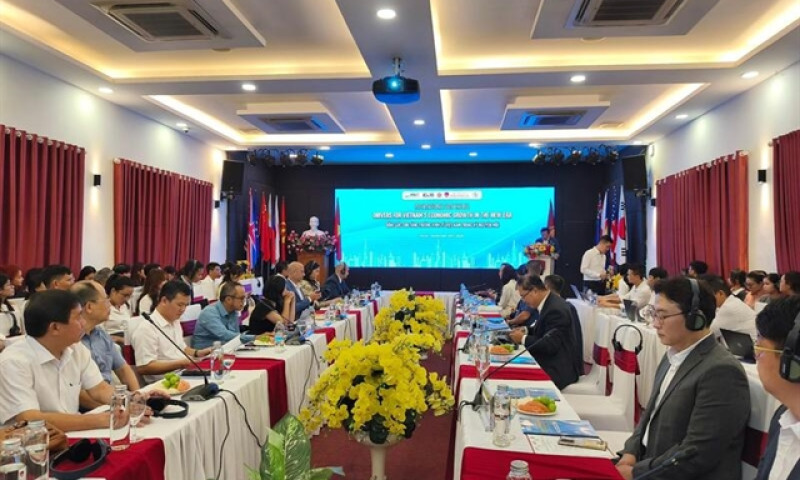Sustainable development of Vietnam’s logistics sector
Vietnam’s logistics sector has significant development potential but faces numerous limitations and obstacles that must be addressed. Experts believe that to transform this sector into one of the economy's key industries, it is necessary to create breakthroughs in the new era.
Current state
According to the Ministry of Planning and Investment (MPI), the market value of Vietnam’s logistics industry reached approximately 40 billion USD in 2023 and is expected to continue growing at about 14-15% annually until 2025. The logistics industry currently contributes about 4-5% of GDP and creates jobs for more than one million direct workers. Additionally, Vietnam’s logistics industry has achieved an average annual growth rate of 14-15%, with a size of 40-42 billion USD annually.
Yap Kwong Weng, CEO of Vietnam SuperPort, states that according to 2023 World Bank data, Vietnam ranked 43rd in the Logistics Performance Index (LPI), placing it among the top five ASEAN countries. According to the Emerging Markets Logistics Index by Agility, a leading global transport and logistics service provider, in 2023, Vietnam ranked 10th out of 50 emerging logistics markets, up one position from the previous year.
This indicates that the shift in global trade has made Southeast Asia a key centre for manufacturing and logistics. Within this context, Vietnam is leading production and trade flows, with exports from Vietnam accounting for more than 20% of Southeast Asia’s total export value to certain regions.
Vietnam has over 17,000 km of inland waterways, of which more than 7,000 km are managed by the central government, and over 10,000 km are managed by local authorities. Regarding inland water transport, there are more than 270,000 vessels, including over 3,000 river and sea transport vessels. These are considered impressive numbers that help reduce current logistics costs.
Despite having many advantages and achieving notable development progress, according to MPI Deputy Minister Do Thanh Trung, Vietnam’s logistics sector still faces several limitations.
Specifically, policies and institutions for the logistics industry are insufficient and not synchronised, lacking a complete legal framework. Meanwhile, transport infrastructure and logistics facilities such as warehouses, yards and logistics centres are limited and not integrated. The sector has not established seamless multimodal transport corridors and lacks logistics centres in strategic locations that connect with seaports, airports, roads and production facilities.
Moreover, Vietnamese logistics companies are limited in terms of expertise, experience, capital and human resources. Their competitiveness remains weak, often playing the role of subcontractors or agents for foreign corporations. Additionally, there is a shortage of trained logistics professionals who meet industry requirements, especially high-level logistics personnel capable of implementing and applying new technologies in businesses.

Comprehensive digital transformation and greening
Sharing the direction for the logistics industry, MPI Deputy Minister Do Thanh Trung recommends that logistics companies improve their operations, accelerate digital transformation, and invest in new technologies to enhance operational efficiency and competitiveness.
According to Trung, these are significant challenges for Vietnamese logistics companies, mostly small and medium enterprises with limited experience, capital and human resource capabilities.
However, this is also a major opportunity as companies are pushed to implement transformation more quickly, strongly and substantially. Accordingly, companies that better grasp new technology waves will surpass others, just as nations that better understand new technology waves will surpass other nations.
From a consulting perspective, Yoshihiro Wake, director of international market development at Abeam Consulting, states that digital transformation is crucial for the logistics industry. Through digital twinning using big data and artificial intelligence (AI), it will be possible to integrate and analyse industry data such as transport routes and methods. This enables monitoring of the entire supply chain process.
Moreover, digital transformation helps improve productivity, increases transparency, and makes project progress easier to track. This builds trust with customers and partners, assisting companies that implement it to stand out in the logistics market.
According to Dinh Thanh Son, Deputy General Director of Viettel Post, the first step in digital transformation is to reshape the workforce. Based on the practical experience of Viettel Post’s digital transformation push with more than 40,000 employees, the company has started digitising its processes and activities. At the same time, it has invested in all stages using tools like IoT and applications for employees. The company has collected data to analyse and create a network management platform. The most important story is that the application of technology will help identify bottlenecks in the system and then allocate and re-invest resources reasonably.
In addition to digital transformation, Cao Hong Phong, Deputy General Director of Gemalink Port (Gemadep), affirmed the need to build a smart and green port-logistics ecosystem, an industry and global trend. The company is exploiting the Gemalink Port in the Cai Mep - Thi Vai area, a key role in connecting trade between Vietnam and major markets including the US, Europe and Inner Asia.
Regarding the logistics industry, companies in the sector say that for green transformation to be effective, it cannot be done unilaterally. Therefore, they hope for the accompaniment and support of the government and relevant ministries and agencies.
Specifically for port operators, there is a need for support to build and develop green supply chains through developing infrastructure and strengthening the connectivity of ports with other transport systems like roads, railways and aviation to create an efficient logistics network.
According to Tran Thanh Hai, Deputy Director of the Export-Import Department under the Ministry of Industry and Trade, the key to reducing logistics costs is accelerating transport infrastructure connections by investing in logistics centres and dry ports and promoting multimodal transport. Infrastructure is a critical factor driving the development of this industry.
Regarding transport infrastructure, Bui Thien Thu, Director of the Vietnam Inland Waterway Administration, said there needs to be a synchronous connection between the inland waterway system and seaports and road networks. Furthermore, the government needs to increase public investment in inland waterway infrastructure, as it currently accounts for less than 2% of total transport infrastructure investment, even though it handles around 20% of total freight volume annually.






